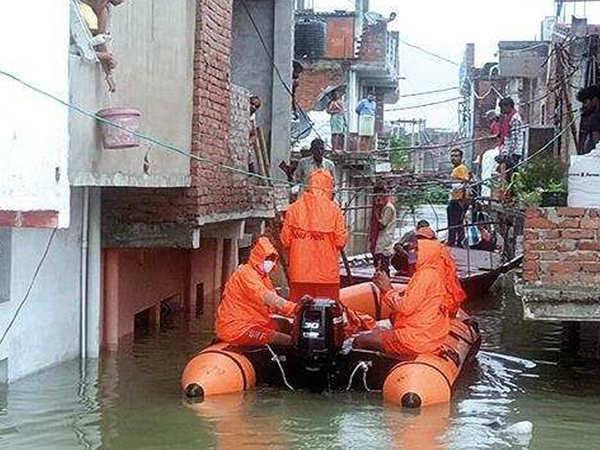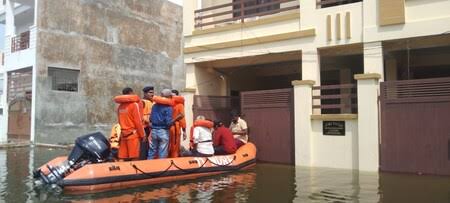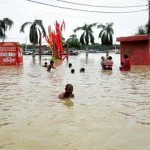Prayagraj, the city of sacred confluence, where the Ganges, Yamuna, and the mythical Saraswati rivers meet, is currently facing one of its most challenging times. The relentless rise in water levels in both the Ganges and Yamuna rivers has brought life to a standstill for many residents. This flooding has not only submerged the low-lying areas of the city but has also transformed the iconic Sangam into a vast expanse of water, overflowing its traditional boundaries.

The Historical Significance of Prayagraj and the Sangam
Prayagraj, formerly known as Allahabad, holds immense religious significance in India. It is the site of the Kumbh Mela, one of the largest religious gatherings in the world, where millions of devotees take a dip at the Sangam, believing that it washes away their sins. The confluence of the Ganges, Yamuna, and Saraswati is considered one of the holiest places in Hinduism. However, the recent floods have cast a shadow over this sacred site, as the rising waters threaten to submerge not just the Sangam, but also the surrounding areas.
The Extent of the Flooding
The recent floods in Prayagraj have been caused by incessant rainfall in the region and the upstream areas, leading to a significant rise in the water levels of both the Ganges and Yamuna rivers. The situation has been exacerbated by the release of water from various dams and barrages along the rivers, which have been filled to capacity due to the heavy rainfall.
As the water levels continue to rise, large parts of Prayagraj, especially the low-lying areas near the rivers, have been inundated. The flooding has affected residential areas, markets, roads, and even some government buildings. Many people have been forced to leave their homes and seek shelter in safer areas, while others are stranded, awaiting rescue.
The Sangam, which is usually a serene and spiritually uplifting place, is now overflowing with water. The water levels have risen so much that the traditional platforms used by pilgrims to perform rituals are completely submerged. The vast expanse of water now stretches far beyond its usual boundaries, creating a scene that is both awe-inspiring and terrifying.
The Impact on Local Communities
The flooding in Prayagraj has had a severe impact on the local communities, particularly those living in the low-lying areas near the rivers. Many homes have been flooded, forcing residents to evacuate and seek refuge in relief camps set up by the government and non-governmental organizations. The rising water levels have also disrupted daily life, with schools, markets, and offices being closed due to the flooding.
In addition to the displacement of people, the floods have also caused significant damage to property and infrastructure. Roads have been submerged, making transportation difficult, and in some cases, impossible. The local economy has also been affected, with many small businesses suffering losses due to the disruption caused by the floods.
The agricultural sector has not been spared either. The fertile lands along the banks of the Ganges and Yamuna, which are usually used for farming, are now under water. This has led to the destruction of crops, which will have long-term effects on the livelihoods of the farmers in the region.
Government Response and Relief Efforts
The government has been actively involved in managing the flood situation in Prayagraj. Various measures have been taken to ensure the safety of the residents and to provide relief to those affected by the floods. Rescue operations have been launched to evacuate people from the worst-hit areas and to provide them with food, water, and medical assistance.
Relief camps have been set up in various parts of the city to accommodate the displaced residents. These camps are equipped with basic amenities, such as food, clean drinking water, and medical facilities. The government is also working closely with non-governmental organizations and local volunteers to ensure that aid reaches those who need it the most.
In addition to providing immediate relief, the government is also focusing on long-term solutions to mitigate the impact of such floods in the future. Plans are being discussed to improve the drainage system in the city and to strengthen the embankments along the rivers to prevent flooding.
Environmental and Ecological Impact
The flooding in Prayagraj is not just a human tragedy; it also has significant environmental and ecological implications. The rising water levels in the Ganges and Yamuna rivers have disrupted the natural habitat of various aquatic species. The strong currents and high water levels can cause the displacement of fish and other aquatic organisms, affecting the biodiversity of the rivers.
Moreover, the floodwaters can carry pollutants from the land into the rivers, further degrading the water quality. This is particularly concerning for the Ganges, which is already heavily polluted. The flooding can also lead to soil erosion, which can have long-term effects on the fertility of the land along the riverbanks.
The ecological impact of the floods extends beyond the immediate vicinity of the rivers. The floodwaters can spread to nearby forests and wetlands, affecting the flora and fauna in these areas. The long-term effects of the floods on the environment will need to be carefully studied and addressed in the future.
The Role of Climate Change
While floods are not uncommon in the region, the intensity and frequency of such events have increased in recent years, raising concerns about the role of climate change. The heavy rainfall that has led to the flooding in Prayagraj is consistent with the predictions made by climate scientists, who have warned that global warming could lead to more extreme weather events, including intense rainfall and flooding.
Climate change can also exacerbate the impact of floods by increasing the melting of glaciers in the Himalayas, which feed the Ganges and Yamuna rivers. As the glaciers melt, they contribute more water to the rivers, increasing the risk of flooding, especially during the monsoon season.
Addressing the impact of climate change on flooding will require a multi-faceted approach. This includes not only improving flood management and disaster preparedness but also taking steps to reduce greenhouse gas emissions and mitigate the effects of climate change.
The Spiritual and Cultural Impact
The flooding of the Sangam has a profound spiritual and cultural impact on the people of Prayagraj and on Hindus across India. The Sangam is not just a physical location; it is a symbol of spiritual purification and renewal. The annual Magh Mela and the Kumbh Mela, which are held at the Sangam, attract millions of devotees from around the world, who come to take a holy dip in the confluence of the rivers.
The current flooding has disrupted these religious practices, with pilgrims unable to perform their rituals at the Sangam. The overflowing waters have made it dangerous to approach the site, and the traditional platforms used for rituals are now underwater.
For many, the flooding of the Sangam is a reminder of the impermanence of life and the power of nature. It serves as a call to reflect on the relationship between humans and the environment, and the need to protect and preserve our natural resources.
The Way Forward
As Prayagraj grapples with the ongoing floods, there is an urgent need to rethink the way we manage our rivers and our cities. The current situation highlights the vulnerability of urban areas to natural disasters and the need for better planning and infrastructure to cope with such events.
One of the key areas that need to be addressed is the management of the rivers themselves. The Ganges and Yamuna are not just rivers; they are lifelines for millions of people. However, years of pollution, encroachment, and mismanagement have taken a toll on these rivers, making them more prone to flooding.
There is a need for a comprehensive approach to river management that includes not only measures to control flooding but also efforts to clean and rejuvenate the rivers. This includes stricter regulations on pollution, better waste management, and initiatives to restore the natural flow of the rivers.
Urban planning also needs to take into account the risks of flooding. Cities like Prayagraj, which are located near major rivers, need to have robust flood management systems in place. This includes the construction of flood barriers, the development of early warning systems, and the creation of emergency response plans.
Public awareness and community involvement are also crucial in managing the impact of floods. Residents need to be educated about the risks of flooding and the steps they can take to protect themselves and their property. Community-based initiatives, such as the creation of local disaster response teams, can also play a key role in managing the impact of floods.

Conclusion
The flooding in Prayagraj is a stark reminder of the power of nature and the challenges we face in managing our environment. As the city copes with the rising waters of the Ganges and Yamuna, it is clear that there is a need for a more sustainable and holistic approach to managing our rivers and our cities.
The immediate focus must be on providing relief to those affected by the floods and ensuring their safety and well-being. However, in the long term, there is a need for a broader conversation about how we can better manage our natural resources and protect our communities from the impact of climate change and natural disasters.
Prayagraj, with its rich cultural and spiritual heritage, has always been a symbol of resilience and renewal. As the city emerges from the current crisis, there is hope that it will continue to be a beacon of hope and inspiration, not just for its residents, but for people across India and the world.











